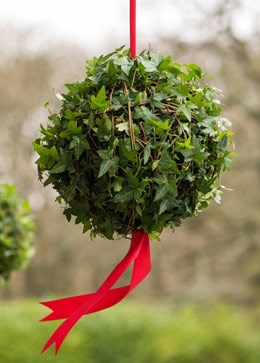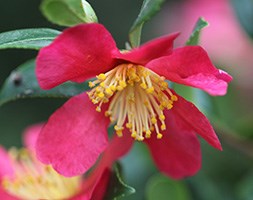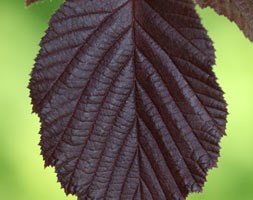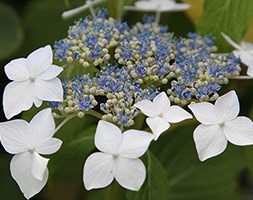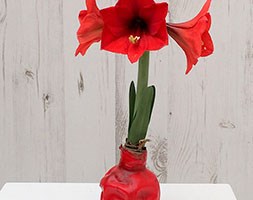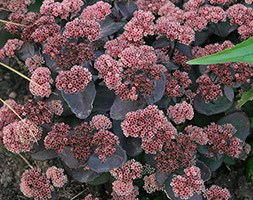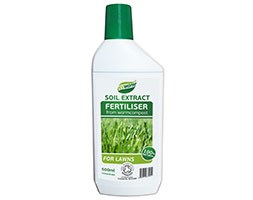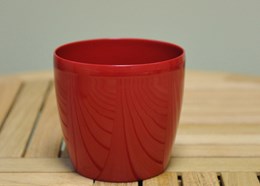New products at Crocus
by Sarah - November 23rd, 2014.Filed under: Crocus, New Products.
Crocus has these new items today
Living ivy ball (Living Ivy ball) £29.99
Position: full sun or partial shade Rate of growth: fast-growing Hardiness: fully hardy Hang this ivy ball in place of your hanging basket during the winter months. The red ribbon provides a festive entrance to visitors. Garden care: Water well regularly during the growing season, providing a balanced liquid fertiliser each month. Keeping moist during the winter months. Plants may be pruned at any time of the year to keep the ball shape
Camellia x vernalis ‘Yuletide’ (camellia) £19.99
Position: partial shade (but not east-facing) Soil: moist but well-drained, humus-rich, acid soil (or ericaceous compost for container-grown specimens) Rate of growth: average Flowering period: November to January Hardiness: fully hardy Glossy dark green leaves provide a sumptuous backdrop for the profusion of yellow-eyed, red flowers, when they appear in late autumn and early winter. Their colouring is very striking – and is perfect for the build up to the Christmas season, but the dark green foliage offers year-round structure and interest. If left to grow naturally, this is a relativly compact shrub with a pyramidal habit, but it can also be trained against a wall, or grown in a large pot if space is at a premium. Garden care: To prevent damage to the emerging buds and flowers protect from cold, dry winds and early morning sun. Water established plants in dry weather to prevent bud drop. Apply a balanced liquid fertiliser in mid-spring and again in June. Top-dress annually with shredded bark or well-rotted leaf mould. After flowering, lightly trim or prune any branches that spoil the appearance of the plant.
Corylus maxima ‘Purpurea’ (filbert) £16.99
Position: full sun Soil: fertile, well-drained, preferably chalky soil Rate of growth: average Flowering period: February to March Flower colour: purple catkins Other features: edible nuts Hardiness: fully hardy Purple-tinged catkins appear in late winter, and are followed by edible nuts, which ripen in mid-August. The heart-shaped leaves emerge a rich purple, then turn a deep green as they mature. This upright filbert makes an excellent specimen tree for a small, sunny garden. The tree’s common name is derived from the edible nuts that ripen about the time of St. Philibert’s Day (20 August). Garden care: Prune dead, diseased and damaged wood in March and apply a 5-7cm (2-3in) mulch of well-rotted organic matter around the base of the plant.
Hydrangea macrophylla ‘Lanarth White’ (lacecap hydrangea) £12.99
Position: full sun or partial shade Soil: moist, well-drained, moderately fertile, humus-rich soil Rate of growth: average Flowering period: July to September Hardiness: fully hardy Garden care: Hydrangeas do not like to dry out. In dry weather, soak the roots with a hose and the plant will usually recover. Remove faded flowerheads in spring after the danger of frosts, cutting back the flowered stems to a strong pair of buds. Take out misplaced or diseased shoots. Mulch young plants with a well-rotted manure or compost in spring. Once established, remove a quarter to a third of the shoots to the base of the plant.
Wax Amaryllis (no water living amaryllis) £12.99
Position: bright but not in full sun Rate of growth: average Flowering period: within 3-6 weeks Hardiness: frost tender (will need winter protection) No water flowers bulbs are handmade with specially amaryllis selected bulbs that don’t need water to grow. The bulb has enough energy for the flower to grow. So just enjoy this easy eye catcher. All guaranteed to be flowering in 3-6 weeks. General care: Avoid placing the bulb in hoter rooms they are best in cooler rooms.
Wax Amaryllis (no water living amaryllis) £12.99
Position: bright but not in full sun Rate of growth: average Flowering period: Hardiness: frost tender (will need winter protection) No water flowers bulbs are handmade with specially amaryllis selected bulbs that don’t need water to grow. The bulb has enough energy for the flower to grow. So just enjoy this easy eyecatcher. All guaranteed to be flowering in 3-6 weeks. General care: Avoid placing the bulb in hoter rooms they are best in cooler rooms. The easy care amaryllis, no watering required.
Wax Amaryllis (no water living amaryllis) £12.99
Position: bright but not in full sun Rate of growth: average Flowering period: Hardiness: frost tender (will need winter protection) No water flowers bulbs are handmade with specially amaryllis selected bulbs that don’t need water to grow. The bulb has enough energy for the flower to grow. So just enjoy this easy eyecatcher. All guaranteed to be flowering in 3-6 weeks. General care: Avoid placing the bulb in hoter rooms they are best in cooler rooms.
Sedum telephium (Atropurpureum Group) ‘Karfunkelstein’ (stonecrop) £7.99
Position: full sun Soil: moderately fertile, well-drained, neutral to slightly alkaline soil Rate of growth: average to fast-growing Flowering period: August to September Flower colour: bright pink Other features: attractive to butterflies and bees Hardiness: fully hardy The fleshy green leaves have a purple tint when they first appear and this becomes more pronounced as they mature until they turn almost beetroot purple. The bright pink flowers emerge in tight clusters late in the summer and will stay on the plant for many months, although their colour will fade. This versatile perennial is a perfect filler plant for a sunny, well-drained spot. A valuable late source of nectar for butterflies and bees, the dried flowerheads provide structure and colour in the winter garden. Garden care: The flowerheads look great left during the winter to add shape and texture to your border. In February and March cut back the old flowerheads and apply a generous 5-7cm (2-3in) mulch of well-rotted garden compost or manure around the base of the plant. Once established, sedums can have a tendency to flop leaving an open and unsightly centre, especially in fertile soil. One technique to help prevent this is the ‘Chelsea chop’. During the last week of May (Chelsea Flower Show week), cut one in every three stems back to the ground. This will produce plants that are less lush and flower slightly later.
Lawn soil extract fertiliser £3.99
This soil extract for lawns is specially formulated to stimulate high quality plant growth for all types of lawns including decorative, domestic and sports use. It is a 100% natural humic fertiliser made from earthworm compost – a high quality natural biohumus. The concentrated extract contains a full complex of humic, fulvic and amino acids with macro and micro elements, soil antibiotics, fitovitamins and micro-organisms for easy plant absorption. This fertiliser improves soil structure which stimulates germination and root growth for increased nutrient appropriation giving bright and saturated colour. It also reduces absorption of nitrated and heavy metals and helps lawns recover faster from mechanical damage, replanting and climatic conditions. Supplied in a 500ml bottle.
Round pot cover £3.99
Made from a high quality plastic with a glossy red finish, this 16cm square pot is 13.5cm tall and will fit the Hippeastrum pot like a glove. It doesn’t have any drainage holes in the bottom, so it can be place directly onto a table without having to worry about leaking water. Available in more than one colour. All colours sold separately.







